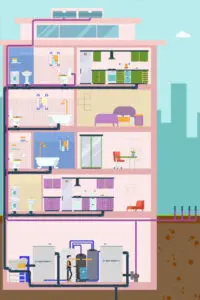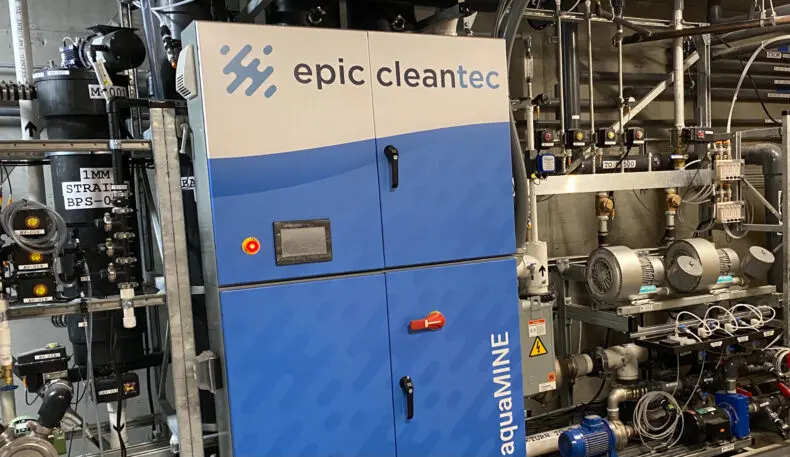Within a few weeks, when someone flushes a toilet in one of San Francisco’s new high-rises, the water won’t drain into the local sewer system. Instead, it will flow into a recently installed machine in the basement, designed to treat the water on-site. After the machine is turned on next month, recycled water will travel back up special pipes so it can be used for the next flush. The solid waste—that is, poop—is treated separately and becomes a product to add to garden soil.
“We’re taking wastewater, which we actually don’t see as waste at all, and we’re showing people that wastewater really just consists of water, it consists of energy, it consists of nutrients, and it consists of organic matter,” says Aaron Tartakovsky, CEO of Epic CleanTec, the startup that makes and manages the recycling tech. “All of those things we can pull out of the wastewater and repurpose.”

In 2015, San Francisco became the first city in the U.S. to require large new buildings to install and run water reuse systems to capture dirty water from pipes and rainwater and use it for flushing and irrigation. (The requirement applies to 250,000-square-foot-plus buildings that received permits after late 2016. There are 24 buildings that meet those requirements currently under construction; so far the law has only affected one completed building.) Though it was permitted before 2016, the 1,070-foot-tall Salesforce headquarters also has a reuse system designed to save as much as 30,000 gallons of freshwater a day, or 7.8 million gallons in a year. Several companies provide this type of technology, but Epic CleanTec is unusual in that it also makes use of solid waste.
The company’s technology was created as part of the Bill and Melinda Gates Foundation’s Reinvent the Toilet Challenge, which asked engineers to create a safe, cheap toilet that could be used by the billions of people around the world who don’t have access to plumbing. Tartakovsky and his father, a building engineer, learned about the tech and realized that it could also be useful in places such as California that struggle with drought.

The company was founded in 2015, at the same time that San Francisco was deciding to mandate more water recycling. “We were in the height of the drought, and our elected officials and the leaders of the utility basically said, ‘Why are we using freshwater from our national parks, from Hetch Hetchy [in Yosemite National Park], to flush our toilets when we can be manufacturing water on-site?,” Tartakovsky says.
The system uses a screen to separate solids and liquids, and then the water is treated to high-quality standards. By law, the water can only be used for nonpotable purposes such as flushing or in cooling towers. But it’s actually clean enough, Tartakovsky says, that it could eventually be used in laundry machines or even for drinking water if the regulations later change. That may happen. In Southern California, Orange County already puts purified wastewater back into groundwater supplies, where it makes its way back into drinking water. California is in another drought now, and as climate change goes on, the amount of rain and snow that the state can rely on will continue to shrink.
The technology treats solid waste by using a powerful chemical reaction. “We’re sterilizing all of the pathogens in the waste; we’re neutralizing all the odor,” he says. “And we’re basically ending up with a sterile product that is full of carbon and full of potassium, so we can do sort of amazing soil blends. . . . We joke that we’re producing soil by San Franciscans for San Francisco,” he says. Right now, the treated waste is trucked to the company’s own demonstration garden, but it could eventually be used in city parks or by farms to reduce the use of fertilizer.

The whole system is designed to use less energy than some competitive technology, cost less, and fit in tight urban spaces. And while it’s particularly useful in cities such as San Francisco that are focused on reducing water use, it could be useful anywhere, especially as aging urban infrastructure strains to keep working. “We’re sort of at this interesting inflection point, globally, where we know the global population is growing,” Tartakovsky says. “We know that most people are moving into cities. And we have an opportunity now to fundamentally rethink how cities are going to design their water and wastewater infrastructure moving forward.”
While the company is focused on California, it’s also planning to launch a philanthropic arm that will address sanitation challenges in other parts of the United States and abroad. “We see an opportunity to supplement the broader water and wastewater industry with a more distributed model,” he says. “Rather than a continued focus on the rehabilitation and expansion of centralized systems, distributed models can save utilities money on their necessary capital expenditures and their ongoing operational spending. But perhaps most importantly, these distributed approaches can quickly bring much-needed solutions to underserved and underinvested communities throughout our nation.”
Recognize your company's culture of innovation by applying to this year's Best Workplaces for Innovators Awards before the extended deadline, April 12.